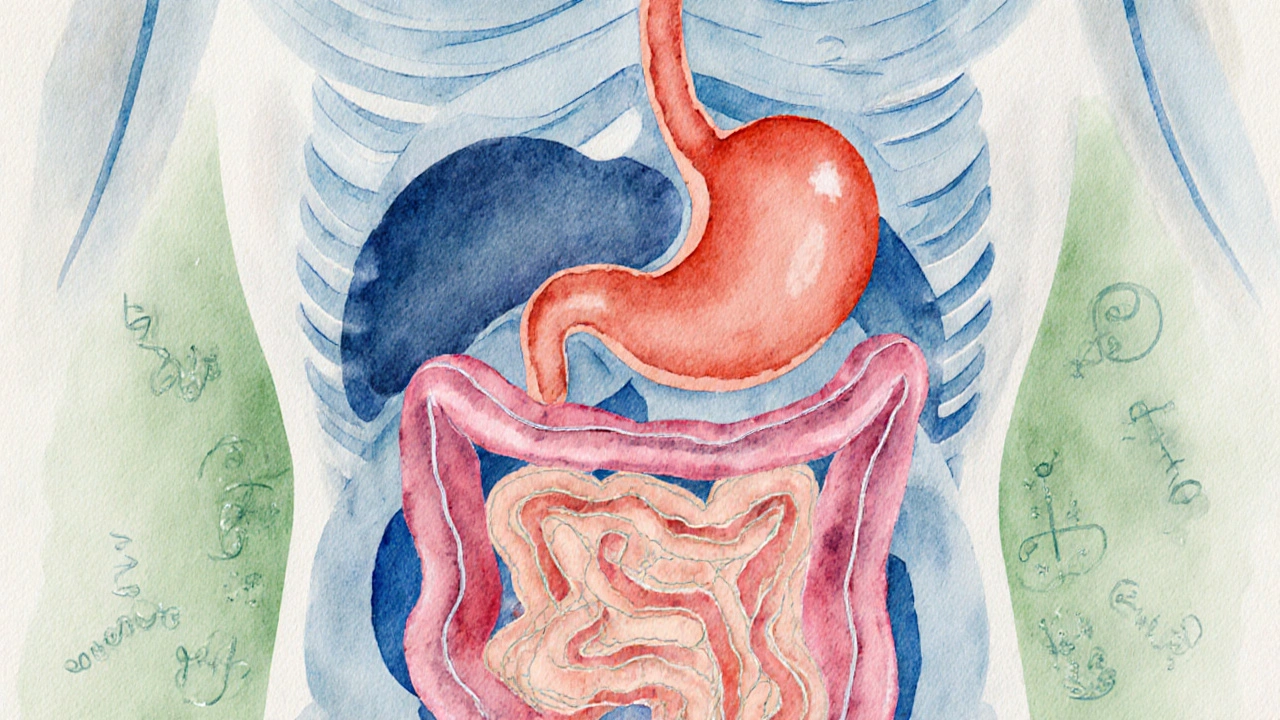Fever Metabolism Calculator
Every degree Celsius your body temperature rises increases your basal metabolic rate by 10-13%. This calculator shows how many extra calories your body burns during fever.
Results
Temperature increase:
Estimated extra calories burned per day:
This is approximately % higher than normal.
Enter your fever temperature to see results
Why this matters
The body uses extra energy to fight infection during fever. This calculator shows how much additional fuel your body needs, which explains why you might lose weight or feel even more fatigued during a fever.
During fever, focus on staying hydrated and eating light, easily digestible foods rather than trying to maintain normal calorie intake.
When a Fever is a temporary rise in body temperature, usually triggered by infection or inflammation, you’ll notice more than just chills and sweat. Your stomach feels off, cravings disappear, and even the way food moves through your gut can change. Understanding why this happens helps you comfort your body and avoid unnecessary complications.
Why a Fever Messes With Your Appetite
During a fever, the hypothalamus - the brain’s thermostat - fires up. This triggers a cascade of hormones and cytokines that shift the body’s priorities from eating to fighting the invader. The Appetite the desire to eat, driven by hormonal signals like ghrelin and leptin drops because the body wants to conserve energy for immune work.
- Hormone shift: Elevated levels of interleukin‑1 (IL‑1) and tumor necrosis factor‑alpha (TNF‑α) suppress ghrelin, the “hunger hormone.”
- Energy reallocation: Muscles and digestive organs receive fewer calories as the liver ramps up acute‑phase protein production.
- Psychological factors: Feeling hot, sweaty, or generally unwell reduces the pleasure of eating.
That’s why many people report a sudden aversion to food or a craving for bland, cool items like ice chips.
How Digestion Slows Down When You’re Burning Up
The Digestion the process of breaking down food and absorbing nutrients in the gastrointestinal tract becomes less efficient for several reasons:
- Reduced gut motility: Fever‑induced sympathetic nervous system activation slows peristalsis, leading to a feeling of fullness or bloating.
- Altered enzyme activity: Higher core temperatures can denature digestive enzymes, so the breakdown of proteins and fats is incomplete.
- Blood flow diversion: More blood is sent to the skin and muscles to help regulate temperature, leaving the gut with less oxygen and nutrients.
These changes often cause nausea, stomach cramps, or even mild diarrhea.
The Metabolic Jump: What Your Body Is Burning
Every degree Celsius the body temperature climbs raises the basal metabolic rate (BMR) by roughly 10‑13%. This Metabolism the sum of chemical reactions that produce energy in the body boost is the engine behind the fever’s energy drain.
Because the body is now burning more calories just to stay alive, the mechanisms that normally signal hunger are overridden. In practical terms, you might lose a pound or two if a fever lasts several days, even if you’re not intentionally dieting.

Immune System Signals: Cytokines and the Gut
The Immune System the network of cells and molecules that defend the body against pathogens releases cytokines to coordinate the fight. While essential, these messengers also affect the gut lining.
- IL‑6 and TNF‑α: Increase gut permeability, sometimes called a “leaky gut,” which can trigger abdominal discomfort.
- Interferon‑γ: Slows gastric emptying, extending the feeling of fullness.
Understanding that these symptoms are part of the immune response can reduce anxiety and help you focus on supportive care.
Dehydration and Nausea: The Double Whammy
Fever raises fluid loss through sweat and faster breathing. Dehydration a deficit of water in the body that hampers normal physiological functions then amplifies nausea, dizziness, and the sluggish gut motility described earlier.
Even mild dehydration can make the stomach feel queasy. That’s why a steady sip of water, broth, or electrolyte solution is often more comforting than a heavy meal.
Practical Tips to Keep Your Gut Happy During a Fever
Here are easy steps you can take to support appetite and digestion while the fever runs its course:
- Stay hydrated: Aim for 150‑200ml every hour. Herbal teas, clear broths, or oral rehydration salts work well.
- Choose easy‑digest foods: Plain rice, bananas, toast, or applesauce provide calories without taxing the gut.
- Eat smaller, frequent meals: Instead of three big plates, try five to six light portions spread throughout the day.
- Cool your body: Lukewarm sponges, cool showers, or a fan can lower core temperature, easing the hormonal appetite suppression.
- Limit fatty or spicy foods: They require more enzyme activity and can worsen nausea.
These strategies don’t cure the fever, but they help you stay nourished and prevent secondary issues like electrolyte imbalance.

When a Fever Needs More Than Home Care
If you notice any of the following, it’s time to call a healthcare professional:
- Persistent vomiting or inability to keep fluids down for 24hours.
- Severe abdominal pain, blood in stool, or persistent diarrhea.
- Fever above 39.4°C (103°F) lasting more than three days.
- Signs of severe dehydration: dry mouth, dark urine, rapid heartbeat, or dizziness upon standing.
Early intervention can prevent complications such as electrolyte disturbances or secondary infections.
Quick Reference: How Fever Changes Your Body
| Aspect | What Happens | Common Symptoms |
|---|---|---|
| Appetite | Hormonal suppression (↓ ghrelin, ↑ cytokines) | Loss of hunger, cravings for bland foods |
| Digestion | Slowed motility, reduced enzyme efficiency | Nausea, bloating, mild diarrhea |
| Metabolism | Basal metabolic rate ↑ 10‑13% per °C | Increased energy use, possible weight loss |
| Hydration | Higher sweat loss, increased respiration | Dry mouth, dark urine, dizziness |
Frequently Asked Questions
Why do I lose my appetite when I have a fever?
Fever triggers cytokines like IL‑1 and TNF‑α that suppress the hunger hormone ghrelin. The body shifts energy away from eating and toward immune activity, so you naturally feel less hungry.
Is it safe to eat normal meals during a fever?
Light, easily digestible foods are best. Heavy, fatty, or spicy meals demand more enzymes, which are already compromised, and can worsen nausea.
How much fluid should I drink when I have a fever?
Aim for at least 1.5‑2liters per day, adjusting upward if you’re sweating heavily. Sipping small amounts regularly works better than gulping large volumes at once.
Can fever cause long‑term digestive problems?
Usually not. The digestive slowdown is temporary. Persistent symptoms after the fever subsides may indicate another underlying issue that should be evaluated.
When should I see a doctor for fever‑related nausea?
If you can’t keep any fluids down for more than 24hours, experience severe abdominal pain, or show signs of dehydration (dry mouth, rapid heartbeat), seek medical attention promptly.


Alisa Hayes
October 12, 2025 AT 04:00When you run a fever your body revs up metabolism, which can make you feel less hungry.
That’s because the hypothalamus is working overtime to fight infection.
The extra calories burned can add up quickly if the fever lasts several days.
Staying hydrated and sipping broths helps keep energy levels steady.
Try small, frequent meals rather than big heavy ones.
Mariana L Figueroa
October 15, 2025 AT 17:53Hydration is key and easy carbs like toast or bananas work great.
mausumi priyadarshini
October 19, 2025 AT 07:45Indeed, while the metabolic increase is measurable, the subjective feeling of reduced appetite, however, varies between individuals, and consequently, nutrition strategies must be personalized, especially for those with pre‑existing conditions.
Carl Mitchel
October 22, 2025 AT 21:38From a physiological standpoint, the rise in basal metabolic rate is not merely a side effect but a deliberate immune response, and ignoring this fact leads to misguided dietary advice.
Suzette Muller
October 26, 2025 AT 11:31It’s helpful to focus on nutrient‑dense fluids-think clear soups, electrolyte drinks, and smooth purees-so the body receives vitamins without taxing the digestive system.
Josh SEBRING
October 30, 2025 AT 01:23Honestly, if you’re feeling fine, don’t stress over calories, just listen to your body and eat when you’re actually hungry.
Lily Tung
November 2, 2025 AT 15:16Fever triggers a cascade of hormonal changes that accelerate energy expenditure.
The hypothalamus raises the set point, causing shivering and increased heart rate.
Each degree Celsius above normal can boost basal metabolic rate by roughly ten to thirteen percent.
This metabolic surge consumes glucose and fatty acids at a faster pace.
As a result, the body may tap into stored glycogen and fat reserves.
The digestive system also slows slightly, which can diminish hunger signals.
People often report a metallic taste and nausea, further reducing appetite.
Dehydration compounds the issue by limiting nutrient transport.
To counteract these effects, consuming easily digestible proteins like broth‑based soups is advisable.
Adding a pinch of salt helps replenish electrolytes lost through sweating.
Light fruits such as berries provide antioxidants that support immune function.
Small, frequent meals prevent overwhelming the stomach while supplying steady calories.
Monitoring weight loss during a prolonged fever can indicate if medical attention is needed.
Rest is equally important because it allows the immune system to allocate resources efficiently.
In summary, matching intake to the heightened metabolic demand helps maintain strength without overtaxing the gut.
Taryn Bader
November 6, 2025 AT 05:08Fever definitely messes with your gut.
Myra Aguirre
November 9, 2025 AT 19:01Keeping it simple with broth and toast works best when you’re running a temperature.
Shawn Towner
November 13, 2025 AT 08:53While most agree hydration is crucial, some argue that over‑emphasizing fluid intake can dilute essential stomach acids needed for digestion.
Ujjwal prakash
November 16, 2025 AT 22:46Honestly, many people overlook the fact that a fever’s metabolic cost isn’t just about calories burned; it also involves hormone shifts, cytokine release, and altered gut motility, all of which demand a nuanced nutrition plan.
Diane Helene Lalande
November 20, 2025 AT 12:39It’s worth noting that even small adjustments, like adding a spoonful of honey to warm tea, can provide quick energy without overwhelming the stomach.
Edwin Levita
November 24, 2025 AT 02:31One could write an epic about the tragedy of a starving fever, yet the practical solution remains simple: sip, chew lightly, and rest.
Xander Laframboise
November 27, 2025 AT 16:24Some claim that a fever automatically means you’ll lose weight, but the reality is that adequate calorie intake can offset the metabolic surge if managed correctly.
Jason Petersen
December 1, 2025 AT 06:16Data shows a correlation between fever duration and weight loss but individual variance is high